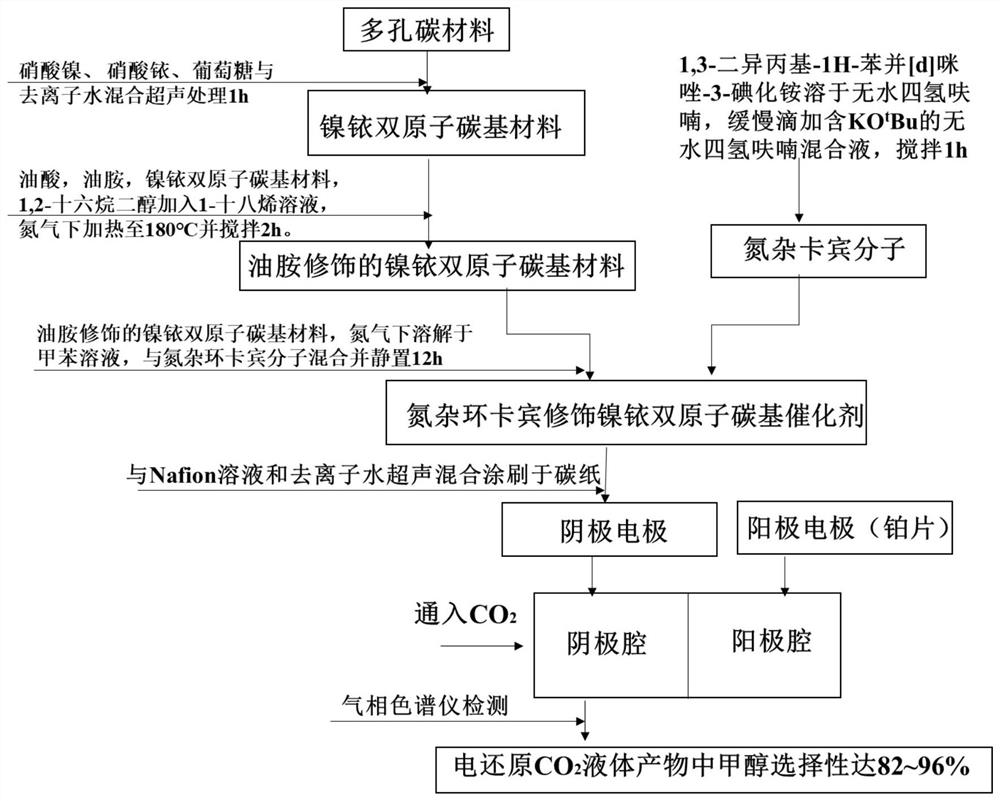Preparation method and application of nitrogen-heterocyclic carbene-modified nickel-iridium diatomic carbon-based catalyst
A nitrogen-heterocyclic carbene, carbon-based catalyst technology, applied in chemical instruments and methods, physical/chemical process catalysts, organic compound/hydride/coordination complex catalysts, etc., can solve problems such as lack and achieve well-developed porous structures , the effect of large specific surface area and strong electrical conductivity
- Summary
- Abstract
- Description
- Claims
- Application Information
AI Technical Summary
Problems solved by technology
Method used
Image
Examples
preparation example Construction
[0031] Such as figure 1 Shown, provide a kind of preparation method of nitrogen-heterocyclic carbene modified nickel-iridium diatomic carbon-based catalyst, specifically comprise the steps:
[0032] (1) Take 5g of sodium citrate and 5g of potassium citrate and mix them evenly, place them in an electric heating tube furnace and feed in argon gas, start the electric heating furnace and control the heating rate to 10°C min -1 , heated to 800°C and then pyrolyzed at constant temperature for 2h. The pyrolysis product was treated with 0.5M H 2 SO 4 The solution and deionized water were washed three times by centrifugation, and then dried in a vacuum oven at 60°C to obtain a porous carbon material.
[0033] (2) Take 0.8g of the porous carbon material in step (1), 3mmol of nickel nitrate, 3mmol of iridium nitrate, 67mmol of glucose and 50mL of deionized water, mix and sonicate for 1h, then centrifuge (8000rpm) and dry at 80°C for 12h to obtain a solid product .
[0034](3) Mix th...
Embodiment 1
[0045] Take 5g of sodium citrate and 5g of potassium citrate and mix them evenly, place them in an electric heating tube furnace and feed in argon gas, start the electric heating furnace and control the heating rate to 10°C min -1 , heated to 800°C and then pyrolyzed at constant temperature for 2h. The pyrolysis product was treated with 0.5M H 2 SO 4 The solution and deionized water were washed three times by centrifugation, and then dried in a vacuum oven at 60°C to obtain a porous carbon material. Take 0.8g of porous carbon material, 3mmol of nickel nitrate, 3mmol of iridium nitrate, 67mmol of glucose and 50mL of deionized water, mix and sonicate for 1h, then centrifuge (8000rpm) and dry at 80°C for 12h to obtain a solid product. Mix the solid product with melamine, control the mass ratio to 1:4, put it in an electric heating tube furnace and feed nitrogen gas, start the electric heating furnace and control the temperature rise rate to 10°C min -1 , heated to 700° C. and ...
Embodiment 2
[0048] Take 5g of sodium citrate and 5g of potassium citrate and mix them evenly, place them in an electric heating tube furnace and feed in argon gas, start the electric heating furnace and control the heating rate to 10°C min -1 , heated to 800°C and then pyrolyzed at constant temperature for 2h. The pyrolysis product was treated with 0.5M H 2 SO 4 The solution and deionized water were washed three times by centrifugation, and then dried in a vacuum oven at 60°C to obtain a porous carbon material. Take 0.8g of porous carbon material, 3mmol of nickel nitrate, 3mmol of iridium nitrate, 67mmol of glucose and 50mL of deionized water, mix and sonicate for 1h, then centrifuge (8000rpm) and dry at 80°C for 12h to obtain a solid product. Mix the solid product with melamine, control the mass ratio to 1:5, place it in an electric heating tube furnace and feed nitrogen gas, start the electric heating furnace and control the temperature rise rate to 10°C min -1 , heated to 800° C. an...
PUM
| Property | Measurement | Unit |
|---|---|---|
| diameter | aaaaa | aaaaa |
Abstract
Description
Claims
Application Information
 Login to View More
Login to View More - R&D
- Intellectual Property
- Life Sciences
- Materials
- Tech Scout
- Unparalleled Data Quality
- Higher Quality Content
- 60% Fewer Hallucinations
Browse by: Latest US Patents, China's latest patents, Technical Efficacy Thesaurus, Application Domain, Technology Topic, Popular Technical Reports.
© 2025 PatSnap. All rights reserved.Legal|Privacy policy|Modern Slavery Act Transparency Statement|Sitemap|About US| Contact US: help@patsnap.com

